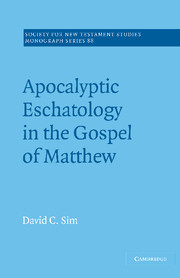Book contents
- Frontmatter
- Contents
- Preface
- List of abbreviations
- Introduction
- Part I Apocalyptic eschatology and apocalypticism
- Part II Apocalyptic eschatology in the gospel of Matthew
- Part III The social setting of the Matthean community and the function of apocalyptic eschatology in the gospel of Matthew
- 8 The social setting of the Matthean community
- 9 The function of apocalyptic eschatology in the gospel of Matthew
- Summary of Part III
- Conclusions
- Select bibliography
- Index of passages cited
- Index of modern scholars
- Index of subjects
9 - The function of apocalyptic eschatology in the gospel of Matthew
Published online by Cambridge University Press: 04 November 2009
- Frontmatter
- Contents
- Preface
- List of abbreviations
- Introduction
- Part I Apocalyptic eschatology and apocalypticism
- Part II Apocalyptic eschatology in the gospel of Matthew
- Part III The social setting of the Matthean community and the function of apocalyptic eschatology in the gospel of Matthew
- 8 The social setting of the Matthean community
- 9 The function of apocalyptic eschatology in the gospel of Matthew
- Summary of Part III
- Conclusions
- Select bibliography
- Index of passages cited
- Index of modern scholars
- Index of subjects
Summary
As noted in chapter 2, the function of apocalyptic eschatology in a given document is directly related to the social setting which underlies it, and is used to respond to it. The gospel of Matthew is no exception to this rule. Thus the purpose of the gospel material reflecting this particular perspective is to confront and combat the situation(s) of crisis which the evangelist's community faced. Like other representatives of apocalypticism, Matthew uses apocalyptic eschatology in order to construct a ‘symbolic universe’ which conflicts with those of the wider societies from which his community is alienated. While he doubtless rejects out of hand the gentile world view, Matthew also dismisses the respective world views of the Jewish parent body and the law-free and dominant wing of Christianity, and replaces them with one which reinforces and legitimates the beliefs and hopes of his own group. Just as the apocalyptic authors used great figures of the past to present and lend authority to their own views of reality, so too does Matthew. By adopting the gospel genre from Mark, Matthew uses no less a figure than Jesus the messiah, son of God and Son of Man to convey and authorise this new symbolic universe. In doing so, Matthew gives his alternative vision of reality an authority and legitimacy which it might not have carried had he not expressed it on the lips of Jesus. The author of Revelation does precisely the same thing, although he appeals to the words of the present, risen Jesus rather than to his teaching prior to his death and resurrection.
- Type
- Chapter
- Information
- Apocalyptic Eschatology in the Gospel of Matthew , pp. 222 - 243Publisher: Cambridge University PressPrint publication year: 1996

